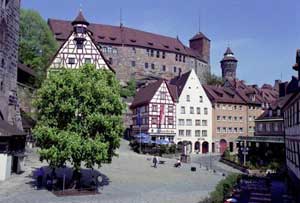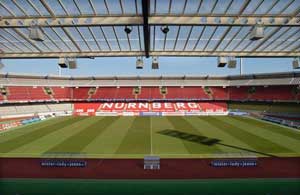
Germany 2006 FIFA World Cup VenuesFIFA World Cup Host Cities - NUREMBERGNuremberg city profile
In the 14th century, the settlement was proclaimed a Free Imperial City. In 1356, Emperor Charles IV stipulated in the "Golden Bull" that every emperor must hold his first Imperial Diet in Nuremberg. The Nuremberg merchants, the so-called "moneybags ", and the city's immensely skilled artisans secured Nuremberg's outstanding position in the Middle Ages. Major works of art were created here - most famously, the woodcarvings of Veit Stoss and the works of Albrecht Dürer. Wars and the resulting shifts in trade routes gradually diminished Nuremberg's importance. In 1649, at the end of the Thirty Years War, the funds of the once prosperous city were exhausted. The Napoleonic invasion accelerated this decline. In 1806, Nuremberg lost its charter as a Free Imperial City and was incorporated in the Kingdom of Bavaria. This, however, soon proved to be a blessing in disguise, as the city rapidly developed, becoming the largest industrial centre in Bavaria. A symbol of this new ascent was the opening in 1835 of Germany's first railway line, between Nuremberg and Fuerth. Today, Nuremberg is in the process of transforming itself from an industrial city to a technology-based service centre. Nuremberg, an important trade fair location, lies at the heart of a conurbation with a total of 2.5 million inhabitants. In addition to football, Nuremberg is also a traditional venue for cycle racing, ice hockey and motor racing. The Norisring race track is famous for the Nuremberg 200 miles car race held there every year. The "Nürnberger " team takes part in international cycling events and is the co-operation partner of the German Telecom team headed by Tour de France winner Jan Ullrich. The Nuremberg Ice Hockey Club's "Ice-Tigers" team plays successfully in the German Ice Hockey League, and the International Track and Field Meeting in Nuremberg is an important fixture in the track and field world. Nuremberg's team 1. FC Nürnberg is a nine-times winner of the German Football Championship. A total of 114 football clubs play in the Nuremberg-Fuerth district, including three-time German champion SpVgg Greuther Fürth - currently playing in the Zweite Bundesliga. 30 international clubs are also integrated in the match activities for which 340 football grounds are available. Major Events at the Nuremberg Franken-Stadion
Nuremberg stadium profilePopulation: 490,000Stadium: Frankenstadion Project: Reconstruction Investment: 56 million Euro Gross Capacity: 41,926 Total Seating Capacity: 36,898 (*) Purchasable Ticket Capacity (**)
From the planning phase onwards, reconstruction at the ground incorporated eco-friendly measures including a vast rainwater collection cistern capable of supplying the stadium's entire sprinkling and watering needs. The arena operates an "Eco Management and Audio Scheme", an environmental optimisation system designed to make the most efficient use of scarce resources. The playing area has been lowered and additional seating installed to increase the number of seats by 5,500 to 45,500 (Bundesliga capacity). The ground floor under the main stand has been transformed into a 300 square metre Mixed Zone, underneath a three-storey VIP building for special guests and the media. All reconstruction measures were completed in April 2005. The new Frankenstadion hosted three matches at the FIFA Confederations Cup 2005, including the group stage meeting between Germany and Argentina, and the Germany v Brazil semi-final. The original 50,000 capacity Municipal Stadium took just three years to construct before opening in 1928. Following 1. FC Nuremberg's eighth German championship triumph in 1961, the city elected to reconstruct the ground in time for the Bundesliga's inaugural season. The stadium was again renovated between 1987 and 1991 and given its current name. Financing: (*) "Total Seating Capacity" means the Gross Capacity less the seats unavailable for use due to restricted views and security/contingency reserves for the 2006 FIFA World Cup. This capacity is estimated and may change once these deductions are finally determined.
|
||||||||||||||||||||||
Recommended Sportsbook
Bookmaker Sportsbook is a recognized sports betting leader since 1985. BookMaker provides safe, legal, and secure betting on major sporting events, as well as horse racing, casino, and poker entertainment, from any location in the world, 24 hours a day 7 days a week. Bookmaker is the number one legal online sports betting and entertainment center of America. Bonded and fully licensed by the Government of Costa Rica. With a reputation like this everyone should have an account.
Bookmaker covers all needs for any real gambler. If you do not have an account with Bookmaker you are making a very big mistake. Signing up now is better than ever as gives you the best bonuses available. With an array of bonuses and the best reputation, Bookmaker is a must have for A list sportsbook betting fans. Sign up today!
 Nuremberg can look back on a long history. The city located at the heart of the Franconia region was already mentioned in 1050 in a document that records a court assembly held there by the German Emperor Henry III in that year. During the dynasty of the Staufen emperors, there was a rapid development of a settlement here, and in 1219 it received its charter of liberty.
Nuremberg can look back on a long history. The city located at the heart of the Franconia region was already mentioned in 1050 in a document that records a court assembly held there by the German Emperor Henry III in that year. During the dynasty of the Staufen emperors, there was a rapid development of a settlement here, and in 1219 it received its charter of liberty.  Only three of the stadiums at the 2006 FIFA World Cup continue to feature an athletics track: Berlin, Stuttgart and Nuremberg. The remaining venues are all football-only stadiums. Nevertheless, the Frankenstadion boasts a unique atmosphere and superb facilities.
Only three of the stadiums at the 2006 FIFA World Cup continue to feature an athletics track: Berlin, Stuttgart and Nuremberg. The remaining venues are all football-only stadiums. Nevertheless, the Frankenstadion boasts a unique atmosphere and superb facilities.